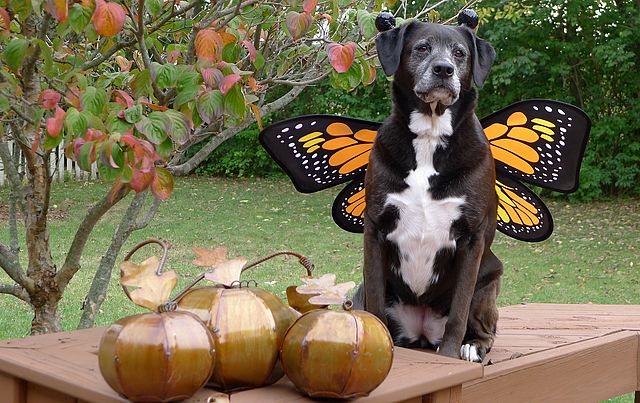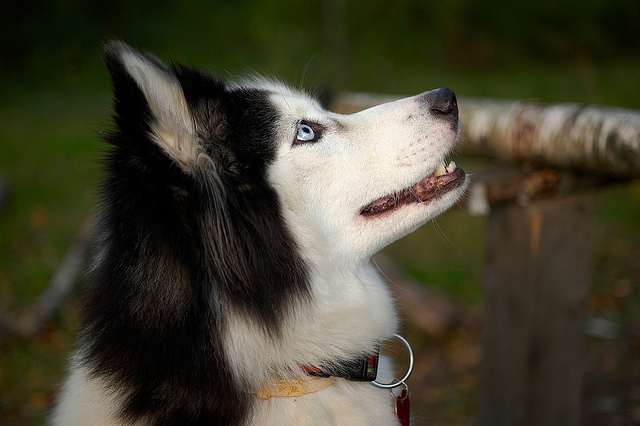
Photo by Andre Hagenbruch / CC BY-SA 2.0
Do you throw birthday parties for your pup or frequently dress your dog in doggie clothes?
Are you a “pet parent” instead of a “pet owner”?
Do you treat your dog like a human?
Almost all of us dog owners are guilty of anthropomorphism. Yes, it’s a long word, but it basically means we sometimes treat animals or objects as if they were human or have human-like traits. It’s a human tendency to want to treat our dogs like fur-covered versions of ourselves because they seem so human-like. They’re often compared to 2 or 3 year-old toddlers with respect to their intelligence and emotional levels and with their human-like facial expressions, it’s understandable why we sometimes treat our dogs like people. But there can be a downside to anthropomorphizing our dogs.
Most behaviorists agree that dogs don’t experience feelings such as greed, spite, revenge, guilt, stubbornness and hatred and they can’t understand our complex human feelings and emotions. Dogs operate with a more basic set of emotions. That may be disappointing for some dog owners to hear, but it makes it easier for us to evaluate and attempt to understand their behavior. We have to accept the fact that dogs don’t share our full range of human emotions and we need to relate to our dogs on their level, in a way they can comprehend. When we put ourselves in their paws, so to speak, and view the world from their perspective, we can better understand how to perform training, fix behavioral issues and create a better relationship with our dogs.
Have you ever anthropomorphized your dog in one of these ways?
These are all examples of how we impose our human feelings and emotions onto our dogs, often causing problems for both of us. Destructive dog behavior is usually caused by excess energy, boredom or teething, not spite or resentment. Dogs will raid trash cans and countertops because they’re scavengers by nature and haven’t yet been trained, not because they’re greedy and feel guilt afterwards. Many times we project our own feelings of guilt or sadness onto our dogs when we leave them home alone.
There’s still so much to learn about the intelligence, behavior and emotions of dogs, but one key to having a rewarding relationship with your dog is to understand that even though your dog seems to have a lot of human-like characteristics, always try to interpret their behavior from their perspective.
Do you ever treat your dog like a human? You can tell us, we all do it sometimes.

 If you’re like me, you may have heard of Leptospirosis and the vaccination for the disease, but don’t fully understand what it is and how it can affect your dog. After learning that the disease is increasing in the United States and Canada, I wanted to know more about it. I didn’t realize how serious the disease is and how vital it is to get early treatment if your dog becomes infected. It’s important to know how it’s transmitted and what symptoms you should look for to protect yourself and your dog. So, what is Leptospirosis?
If you’re like me, you may have heard of Leptospirosis and the vaccination for the disease, but don’t fully understand what it is and how it can affect your dog. After learning that the disease is increasing in the United States and Canada, I wanted to know more about it. I didn’t realize how serious the disease is and how vital it is to get early treatment if your dog becomes infected. It’s important to know how it’s transmitted and what symptoms you should look for to protect yourself and your dog. So, what is Leptospirosis? That’s right, it’s that time of the year again when your dog wonders why things are suddenly being strapped to his back and head followed by lots of hysterical laughter from his humans. Plenty of dogs are good sports and even like getting dressed up in costumes and strutting around, but others can get a little overwhelmed by it all. These ten Halloween dog tips will keep your dog happy and safe so he can enjoy the scarefest as much as you do.
That’s right, it’s that time of the year again when your dog wonders why things are suddenly being strapped to his back and head followed by lots of hysterical laughter from his humans. Plenty of dogs are good sports and even like getting dressed up in costumes and strutting around, but others can get a little overwhelmed by it all. These ten Halloween dog tips will keep your dog happy and safe so he can enjoy the scarefest as much as you do.
